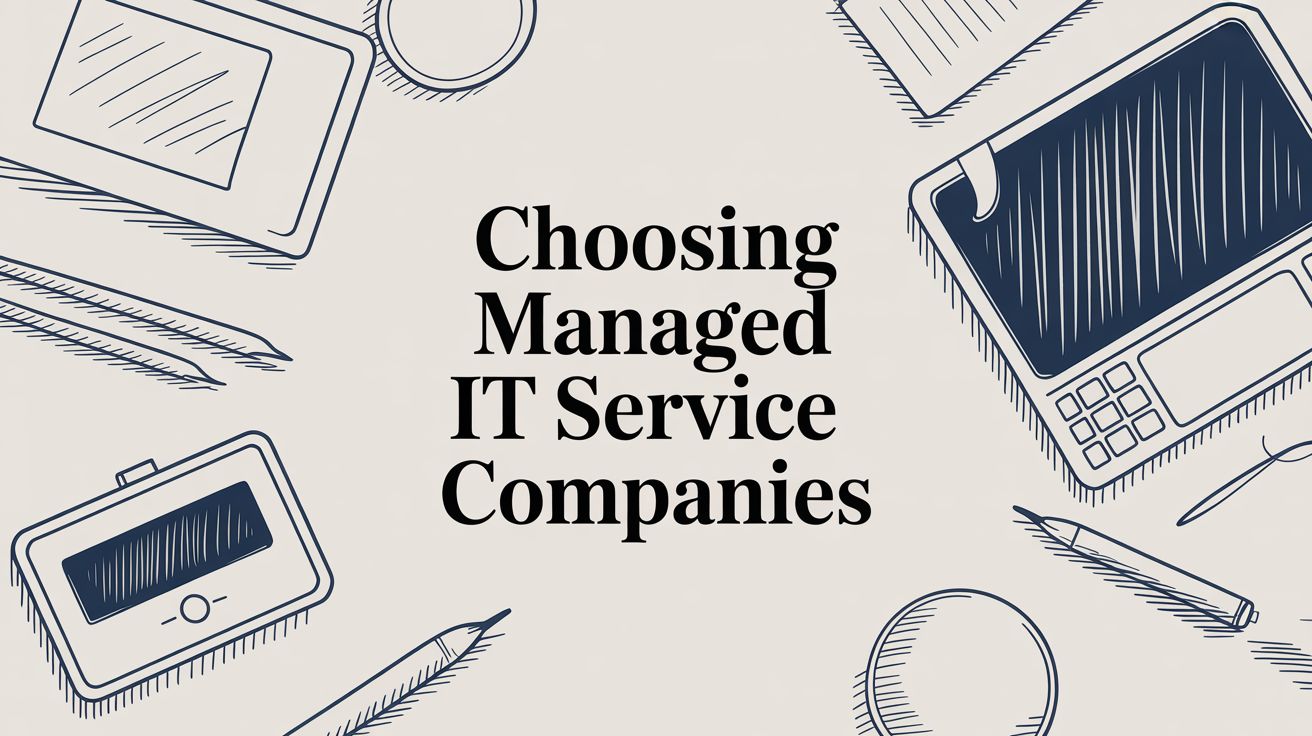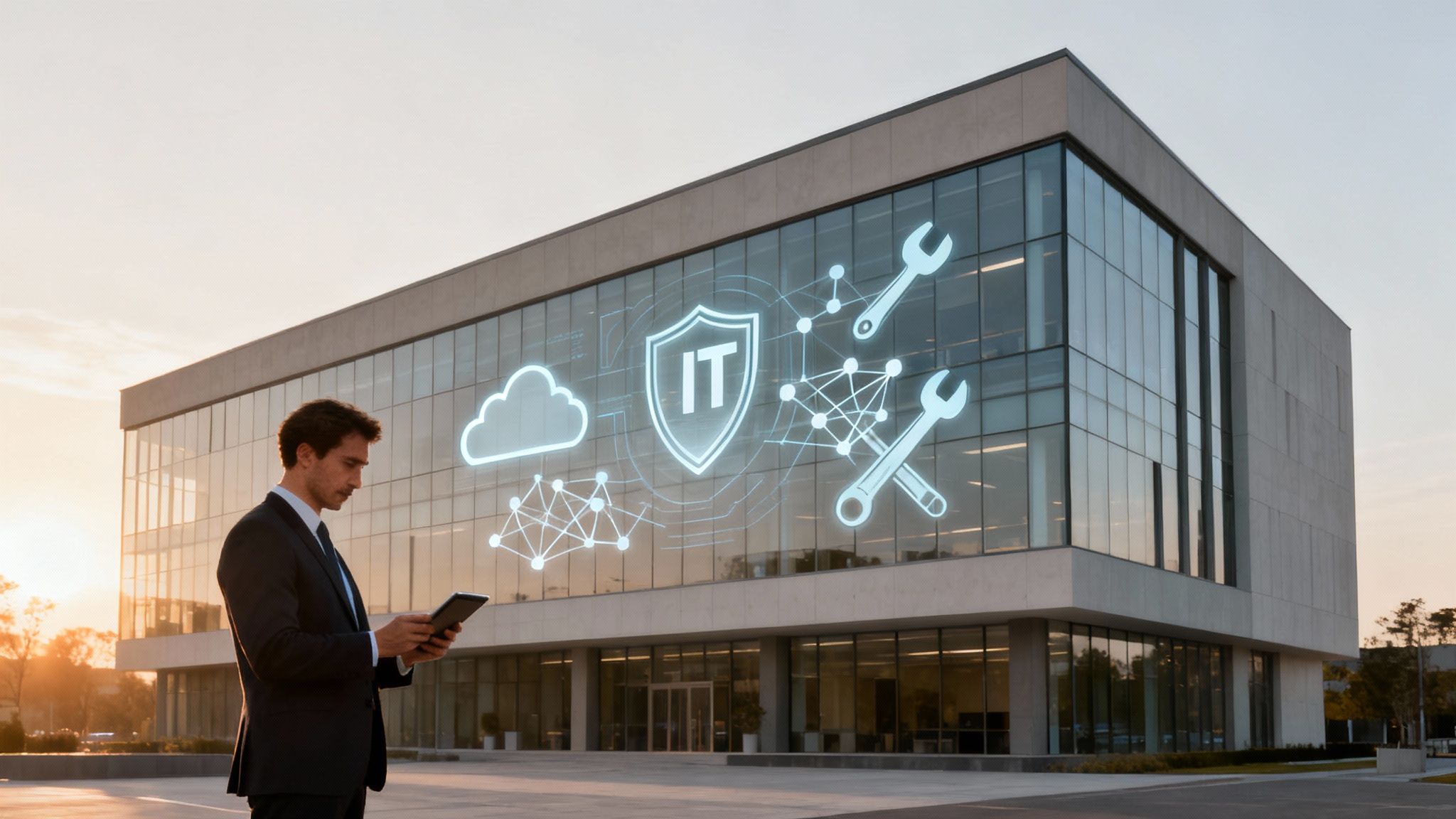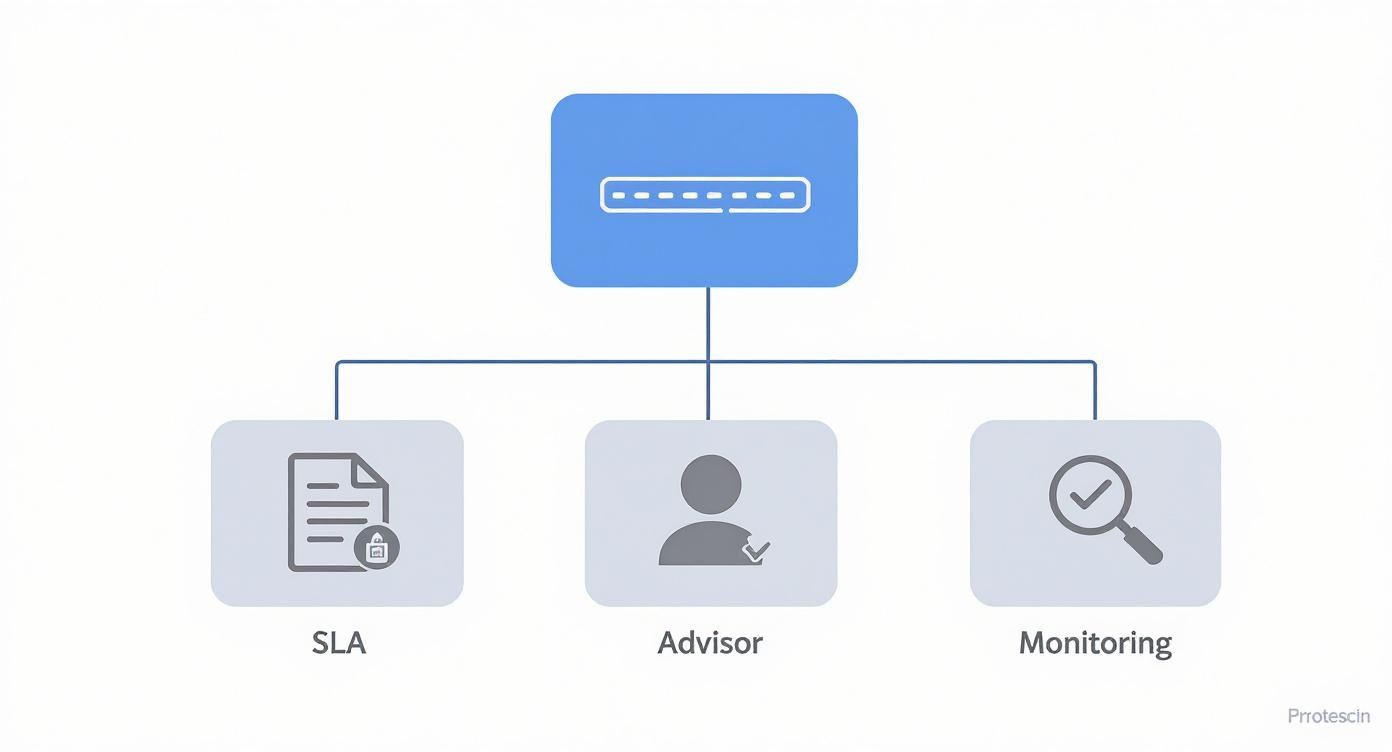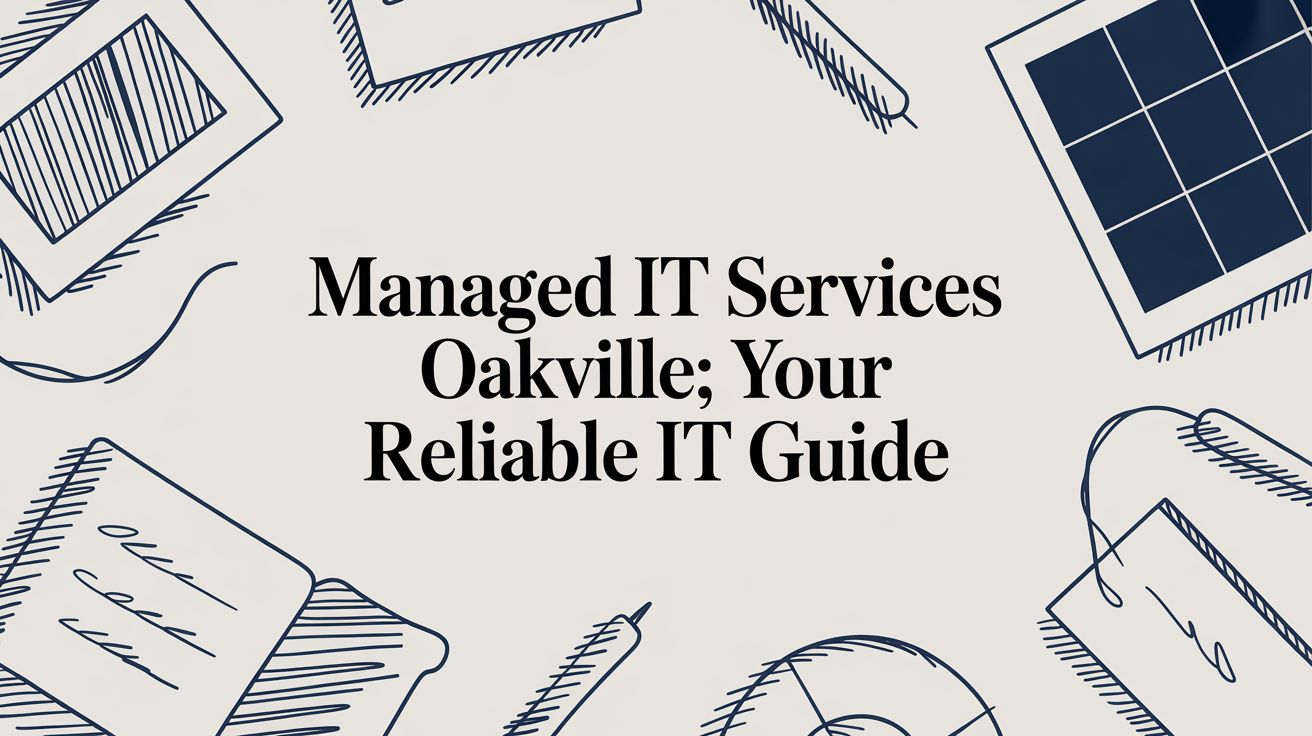
November 18, 2025
Choosing Managed IT Service CompaniesLearn how managed IT service companies work, what they offer, and how to choose the right partner for your business to drive growth and efficiency.
Read Full Post%20(1).webp)
Usman Malik
Chief Executive Officer
November 19, 2025

A managed IT service is about shifting your mindset. Instead of waiting for tech problems to derail your day, you bring in an external team of experts to take full ownership of your entire technology environment. It's the difference between reactive firefighting and a proactive strategy focused on prevention, optimization, and—best of all—predictable costs.
Think of your company’s IT like a complex commercial building. You could hire electricians, plumbers, and security guards one by one, calling them only when a pipe bursts, the power goes out, or a door is left unlocked. That reactive approach is chaotic, inefficient, and almost always costs you more in downtime and emergency fees.
Now, imagine hiring a single, expert building manager who handles everything proactively. They would inspect the wiring before it frays, check the plumbing before it leaks, and monitor security feeds 24/7.
That’s exactly what a managed IT service does for your technology. A Managed Service Provider (MSP) becomes your dedicated tech partner, not just a number to call when things go wrong. They take complete ownership, monitoring your systems around the clock, keeping security airtight, managing updates, and making sure everything just works.

The old way of doing things—often called the "break-fix" model—is fundamentally flawed. You only pay for IT support when something breaks, which means the IT company actually profits from your problems and downtime. It’s a clear conflict of interest.
A managed IT service completely flips that model on its head.
You pay a predictable monthly fee for continuous, proactive maintenance and support. This simple change aligns our goals with yours; we succeed only when your systems are stable, secure, and running at peak efficiency. This strategic shift brings immediate advantages:
A true managed IT service partnership is about more than just outsourcing tasks; it’s about gaining a strategic advisor dedicated to using technology to help your business achieve its goals.
This partnership frees your team to stop worrying about day-to-day IT fires and start focusing on the big-picture initiatives that actually drive growth. Your technology transforms from a constant cost centre into a reliable asset that fuels innovation and productivity, giving you a powerful competitive edge.
Think of a managed IT service not as a simple fix-it shop, but as a complete ecosystem designed to keep your business running at its peak. Instead of just patching problems as they pop up, it’s about weaving together proactive strategies and expert oversight to prevent issues from happening in the first place.
This whole relationship is built on a foundation of accountability, which is where a Service Level Agreement (SLA) comes in. It’s not just a contract; it’s a performance guarantee. The SLA clearly defines things like response times, uptime targets, and how success is measured, ensuring your provider is always on the hook to protect your operations.
Then there’s the strategic side. A vCIO (Virtual Chief Information Officer) acts like a seasoned co-pilot for your entire IT environment. Their job is to translate complex tech choices into clear business outcomes, making sure every dollar you spend on technology fuels growth, not just basic maintenance.
For instance, an SLA might guarantee a 2-hour response time for critical incidents, giving you total clarity on what to expect when things go wrong. This helps you prioritise what matters and aligns your IT support directly with your business needs.
So, what does this look like in practice? It boils down to a few critical components working in harmony.
Together, these elements are the engine that maintains uptime, steers your long-term strategy, and gets ahead of disruptions before they impact your bottom line.
For medium-sized organizations, this approach brings much-needed control and clarity to technology investments. The payoff is real and immediate.
Ultimately, these benefits transform your IT from a reactive, unpredictable expense into a proactive asset that genuinely drives efficiency and opens doors to innovation.
A true managed IT partnership goes beyond just the basics. Most comprehensive services also bundle in critical functions like backup and disaster recovery, modern communication systems, and compliance support.
This unified approach brings all your critical IT functions under one roof, eliminating disconnected silos and dramatically improving your company's overall resilience.
The demand for these services isn't just a local trend; it's a global phenomenon. The managed services market is on a steep growth curve, projected to climb from USD 441.1 billion in 2025 to a staggering USD 1,314.9 billion by 2035. That's a compound annual growth rate (CAGR) of 11.5%, highlighting just how quickly businesses are adopting this model. (Source: Future Market Insights).
This chart gives you a clear visual of just how fast the industry is expanding.
The upward trend is undeniable, showing accelerating demand and revenue across every region.
To put this into perspective, here’s a quick comparison of the global market versus the projections for the US, a key driver of this growth.
This data shows that North American growth is incredibly strong, slightly outpacing the global average and signalling a mature, high-demand market.
To see how these market trends translate into tangible value for your business, check out our guide on the Benefits of Managed IT Services.
"When you align SLAs, vCIO expertise, and proactive monitoring, your IT stops being a cost centre and becomes a strategic growth engine."
Use this foundation to ask the right questions and find a provider that understands both your technical requirements and your business vision. Up next, we’ll dive into how 24/7 network monitoring and robust cybersecurity put these strategies into action.
When you bring on a managed IT service provider, you are not just buying a single product. You're getting a full toolkit of solutions, each designed to tackle specific business challenges. Every service plays a critical role, and together they create a stable, secure, and efficient tech environment that actually supports your company's goals.
Think of it this way: your business has a variety of operational needs, and a good managed IT partner provides the right tool for each job. From keeping your network humming along to defending against the latest cyber threats, these services form a complete support system. Let's pull back the curtain on the most common offerings to see what you really get.
This is the bedrock of any solid managed IT service. Instead of waiting for a server to crash or the network to go down, providers use advanced tools to keep a watchful eye on your systems 24/7. This constant vigilance means they can spot and fix potential issues long before they ever affect your team.
For instance, an alert might flag a server's memory usage spiking abnormally. A technician can jump in and fix the root cause—perhaps a buggy piece of software—before it grinds your whole system to a halt. To get a deeper look at the technology behind this, check out our guide on remote monitoring and management.
The infographic below shows how all the core pieces of a managed IT service fit together, from high-level strategy down to round-the-clock oversight.

As you can see, things like Service Level Agreements (SLAs), vCIO guidance, and active monitoring are the pillars holding everything up, ensuring both reliability and strategic direction.
To give you a clearer picture, here's a quick breakdown of how these core services stack up.
The table below summarizes the main services you can expect from an MSP, highlighting what they do and why it matters for your business.
Each of these services is a building block for a resilient and forward-thinking IT strategy.
In today's threat-filled world, having strong security is simply non-negotiable. A managed IT service shifts your business from a reactive "what if" mindset to a proactive defence strategy. This is about so much more than just installing antivirus software.
It’s a comprehensive, multi-layered approach that includes:
Whether you're already on cloud platforms like Microsoft Azure and AWS or just thinking about moving, managing them effectively is a full-time job. A managed IT provider makes sure your cloud environment is secure, affordable, and perfectly suited to what your business actually needs.
This involves everything from helping you pick the right services and managing the migration with minimal disruption, to constantly fine-tuning your setup so you are not wasting money. For many companies, this optimization work alone results in major monthly savings.
Imagine if your most critical business data simply disappeared tomorrow because of a server failure, ransomware attack, or even a fire. A solid Backup and Disaster Recovery (BDR) plan is your business's insurance policy against that kind of catastrophic data loss.
A managed BDR service is not just about making copies of files; it's about making sure you can get back up and running quickly and predictably when the worst happens. This includes creating a detailed recovery plan and testing it regularly to prove it works.
A provider might set up a system that takes snapshots of your servers every hour. If a ransomware attack locks up your files, you can just roll the system back to how it was an hour ago, effectively neutralizing the threat with almost no data loss or downtime.
Modern businesses need tools that keep teams connected, whether they are in the same office or scattered across the country. A managed Voice over IP (VoIP) service replaces your old-school phone lines with a flexible, internet-based system that brings together voice, video, and messaging.
This lets your team make and receive business calls from any device, anywhere. It makes remote work a breeze, improves collaboration, and often cuts your monthly phone bill—all while being managed and supported by your IT partner.
Figuring out the value of a managed IT service goes way beyond simply fixing computers; it’s about real, tangible business outcomes. If you are just comparing an MSP’s invoice to what you would pay an in-house IT person, you are missing the bigger picture. The real return on investment (ROI) comes from looking at both direct cost savings and the strategic advantages that actually fuel your growth.
The most obvious financial win is predictable monthly costs. No more budget-busting surprises when a server crashes. But more importantly, you save a fortune by slashing downtime. For most businesses, even a single hour of a network outage can cost thousands in lost revenue and productivity, which makes proactive IT management one of the smartest cost-control tools you can have.

Beyond just preventing costly downtime, a great managed IT service delivers ROI in ways that are not always obvious at first glance. These are the financial gains that come from having smoother operations and using your resources more intelligently.
Think about it in these key areas:
These efficiencies are not just "nice-to-haves"; they translate directly to a healthier bottom line.
By outsourcing IT management, businesses can redirect internal resources from reactive problem-solving to proactive, strategic initiatives. This shift does not just save money; it creates new opportunities for growth and innovation.
Let's walk through a common example to make this real. Imagine a medium-sized manufacturing firm with 50 employees. They are dealing with about four hours of IT-related downtime every month. Their one in-house IT person is completely swamped, security is a constant worry, and productivity is taking a hit.
Here’s how partnering with a managed IT service completely changes the game for them:
Before the MSP:
After the MSP:
In this scenario, the direct savings from reduced downtime almost cover the MSP's fee on their own. But when you factor in the strategic benefits—like rock-solid security, predictable costs, and higher productivity—the ROI becomes undeniable. The partnership transforms IT from a frustrating liability into a powerful asset that drives profitability and gives them a real competitive edge.
Picking a managed IT service provider is a lot like choosing a business partner. You’re trusting them with your most critical systems, so you need someone who gets your business, anticipates problems before they happen, and has your back when things go wrong.
Making the right choice requires looking beyond a sales pitch. It’s about evaluating their technical chops, their processes, and whether they are a good cultural fit for your team.
To get past the buzzwords and understand what a provider truly offers, start by asking the right questions.
These questions shift the conversation from what they say they do to what they can actually deliver.
A Service Level Agreement (SLA) is not just another contract; it’s the provider’s promise to you, written down. Do not just skim it—read between the lines to understand what’s actually guaranteed.
First, look at response times. For critical issues that bring your business to a halt, you should expect a response in 2 hours or less.
Next, find the uptime guarantee. This is the percentage of time your systems will be available. Anything less than 99.9% availability over a year should be a deal-breaker.
Finally, check for penalty clauses. What happens if they do not meet their targets? Clear service credits ensure they have skin in the game and are held accountable.
Getting clear on these details from the start prevents misunderstandings and surprise costs down the road.
During your evaluation, be on the lookout for warning signs. Vague promises or missing details can often signal deeper issues.
“An MSP that avoids specifics is often hiding potential weaknesses,” warns industry consultant Jane Smith.
Catching these red flags early can save you from a partnership that’s a poor fit and costly to escape.
Ultimately, finding the right provider also comes down to aligning on culture and communication. A great MSP should feel like a natural extension of your own team. For more on what separates the best from the rest, you might be interested in our guide on managed IT service companies.
A good MSP solves today’s problems. A great MSP helps you prepare for tomorrow’s opportunities. Your provider should be a strategic partner who shares your vision for growth.
Talk to them about their own roadmap. Are they investing in new technologies? How will they support you with initiatives like cloud migrations or provide strategic vCIO guidance?
Choosing a provider with a forward-thinking strategy ensures they will grow with you, not hold you back. By combining targeted questions, a thorough SLA review, and a focus on strategic alignment, you will find an MSP that truly acts as an extension of your company.
Right, let's move past the theory. It's one thing to talk about what a managed IT service does, but it’s another to see the real-world impact. The true value shines when you see how businesses, facing their own unique hurdles, use a strategic IT partnership to not just solve problems, but to get ahead.
These stories are not just about fixing broken tech. They show the incredible shift from a reactive, "firefighting" IT model to a proactive one that fuels growth. From locking down security in highly regulated fields to dragging legacy systems into the modern era, the right provider delivers a genuine competitive edge.
Let's look at a couple of real-life scenarios.
Picture a medium-sized healthcare clinic, constantly wrestling with Canada's stringent Personal Information Protection and Electronic Documents Act (PIPEDA). Their internal IT team was small, stretched thin, and simply did not have the deep-seated cybersecurity expertise needed to properly manage sensitive patient data. This left them exposed to breaches, facing the threat of massive fines, and living with the constant anxiety of a potential audit.
Partnering with a managed IT service provider who specializes in healthcare changed everything.
The result? The clinic did not just tick the box for PIPEDA compliance; they built a true culture of security. With the MSP handling the tech, the clinic's staff could pour all their energy into patient care, fully confident that their sensitive data was in expert hands.
This is a perfect example of turning a massive business risk into a smoothly managed operation. For any business in a regulated sector, this level of specialized support is not just a nice-to-have—it's essential.
Now, let's think about a family-owned manufacturing firm. Their operations were stuck in another decade, running on aging on-premise servers that were slow, unreliable, and costing a fortune to keep alive. Communication between the office and the shop floor was a mess, leading to production slowdowns and frustrated staff. They knew the cloud was the answer, but the path to get there was a total mystery.
A managed IT service provider with serious cloud migration chops stepped in to lead the way.
This move completely revitalized the company. Production efficiency shot up, employees were happier and more productive with tools that just worked, and the business finally had the flexibility to scale up without needing to buy a single new server. It's a clear-cut case of how an MSP can be a catalyst for operational excellence.
Across North America, businesses in key economic hubs are seeing similar benefits. For example, California’s managed services sector is thriving, with providers offering specialized support to industries like finance, healthcare, and technology to ensure predictable budgets and outcomes. You can learn more about how different regions are leveraging MSPs to drive growth.
At CloudOrbis, we make sure every client journey is as smooth and successful as these examples by following our proven 10-step engagement model. And with our 100% Canada-based support team, you get the local expertise and reliable partnership your business needs to truly thrive.
We get a lot of questions about how managed IT services actually work. Here are a few of the most common ones, broken down into simple terms.
What’s the real difference between managed services and break-fix support?
Think of it like this: break-fix support is the firefighter. They only show up after the fire has started, reacting to a problem that's already causing damage and downtime.
Managed IT services, on the other hand, are the fire marshal. We're on-site constantly, monitoring your systems, performing maintenance, and preventing problems before they can ever flare up. This proactive approach means fewer surprise breakdowns and no more emergency repair bills.
How do Service Level Agreements protect my business?
A Service Level Agreement, or SLA, is our promise to you, written down in black and white. It turns vague assurances into measurable commitments you can count on, defining exact expectations for system uptime and how quickly we'll respond to an issue.
Key metrics like a 99.9% availability guarantee or a 2-hour response window for critical issues give you predictable, reliable support. You know exactly what to expect and when problems will be addressed.
This framework ensures we deliver on our promises and protects your operations from unexpected delays.
Is a vCIO service only for large enterprises?
Absolutely not. A virtual Chief Information Officer (vCIO) provides high-level strategic IT planning at a fraction of the cost of hiring a full-time executive.
Even medium-sized organizations gain immense value from roadmap workshops, budget alignment, and regular technology reviews. A vCIO helps transform your IT from a necessary expense into a powerful driver for business growth.
How does an MSP help us stay compliant with regulations?
Navigating regulations like PIPEDA or PCI DSS can be a massive headache. A good managed services provider (MSP) embeds compliance directly into your daily operations.
We manage the audit trails, run the vulnerability scans, and handle the documentation so you are always prepared for an audit. With regular, clear reporting, your team can stop worrying about complex regulations and focus on what you do best.
“A robust managed IT service not only fixes problems but prevents them while keeping you compliant.”
Have more questions? Our team is here to help. Contact CloudOrbis Inc. today to explore our managed IT service solutions and discover how a strategic partnership can drive your business forward.
Visit the CloudOrbis Inc. website for more details now.

November 18, 2025
Choosing Managed IT Service CompaniesLearn how managed IT service companies work, what they offer, and how to choose the right partner for your business to drive growth and efficiency.
Read Full Post
November 17, 2025
IT Solutions for Small Businesses in CalgaryDiscover the essential IT solutions for small businesses in Calgary. This guide covers managed IT, cybersecurity, and cloud services to fuel your growth.
Read Full Post
November 16, 2025
Your Guide to Managed IT Services in OakvilleDiscover managed it services oakville options, compare top IT partners, and find a trusted solution to boost security, efficiency, and growth.
Read Full Post